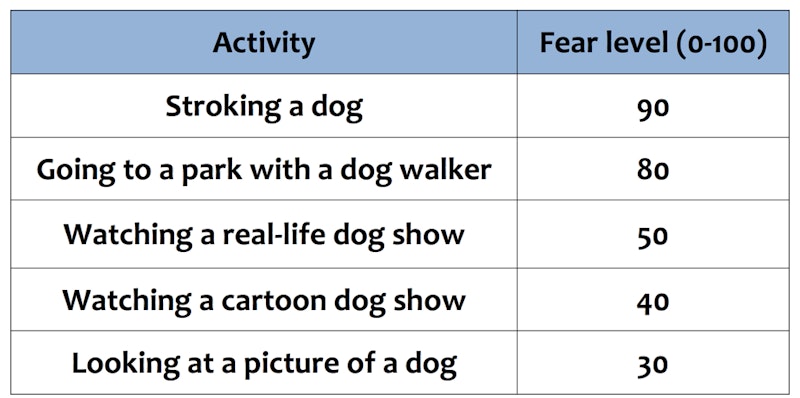Study Notes
Treating Phobias - Systematic Desensitisation
- Level:
- AS, A-Level
- Board:
- AQA, Edexcel, OCR, IB
Last updated 22 Mar 2021
There are two behaviourist therapies used to treat phobias, systematic desensitisation and flooding. Both therapies use the principles of classical conditioning to replace a person’s phobia with a new response – relaxation.
Systematic desensitisation uses reverse counter-conditioning to unlearn the maladaptive response to a situation or object, by eliciting another response (relaxation).There are three critical components to systematic desensitisation:
- Fear hierarchy
- Relaxation training
- Reciprocal inhibition
Firstly, the client and therapist work together to develop a fear hierarchy, where they rank the phobic situation from least to most terrifying.
For example:

Thereafter, an individual is taught relaxation techniques, for example breathing techniques, muscle relaxation strategies, or mental imagery techniques.
The final component of systematic desensitisation involves exposing the patient to their phobic situation, while relaxed.
According to systematic desensitisation, two emotional states cannot exist at the same time, a theory known as reciprocal inhibition.
Therefore, a person is unable to be anxious and relaxed at the same time and the relaxation should overtake the fear. The patient starts at the bottom of the fear hierarchy and when the patient can remain relaxed in the presence of the stimulus, they gradually progress onto the next level. The patient gradually moves their way up the hierarchy until they are completely relaxed in the most feared situation; at this point systematic desensitisation is successful.
Evaluation of systematic desensitisation
One strength of systematic desensitisation comes from research evidence which demonstrates the effectiveness of this treatment for phobias.
McGrath et al. (1990) found that 75% of patients with phobias were successfully treated using systematic desensitisation, when using in vivo techniques (see below). This shows that systematic desensitisation is effective in treating phobias.
Extension: Further support comes from Gilroy et al. (2002) who examined 42 patients with arachnophobia (fear of spiders). Each patient was treated using three 45-minute systematic desensitisation sessions. When examine three months and 33 months later, the systematic desensitisation group were less fearful than a control group (who were only taught relaxation techniques). This provides further support for systematic desensitisation, as a long-term treatment for phobias.
However, systematic desensitisation is not effect in treating all phobias. Patients with phobias which have not developed through a personal experience (classical conditioning) for example, a fear of heights, are not effectively treated using systematic desensitisation. Some psychologists believe that certain phobias, like heights, have an evolutionary survival benefit and are not the result of personal experience, but the result of evolution. These phobias highlight a limitation of systematic desensitisation which is ineffective in treating evolutionary phobias.
You might also like
Phobias (Introduction)
Study Notes
Characteristics of Phobias
Study Notes
Explaining Phobias – The Two-Process Model
Study Notes
Observational Learning
Study Notes
Teaching Phobias at London Zoo
23rd June 2016
Secondary Schools Offer Mental Health Training
17th January 2017
In Numbers: Mental Health in Children & Young People
17th January 2017
Phobias - "MatchUp" Activity
Quizzes & Activities
Daily Email Updates
Subscribe to our daily digest and get the day’s content delivered fresh to your inbox every morning at 7am.
Signup for emails